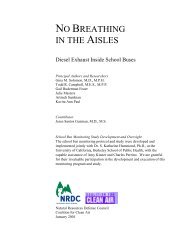p.53-94 (pdf) - Natural Resources Defense Council
p.53-94 (pdf) - Natural Resources Defense Council
p.53-94 (pdf) - Natural Resources Defense Council
You also want an ePaper? Increase the reach of your titles
YUMPU automatically turns print PDFs into web optimized ePapers that Google loves.
Appendix C U.S. Nuclear Weapons, Location Profiles, CONTINUED<br />
1992 four F-117A Stealth fighters from Tonopah Test Range, Nevada arrived at Holloman, and over<br />
the next two months the rest of the aircraft arrived. The 49th Wing received an operational readiness<br />
inspection (ORI) from 23-31 June 1995 which included evaluation of the ability of the Wing to receive and<br />
guard nuclear weapons.<br />
Air Combat Command also conducted Nuclear Staff Assistance Visits at Cannon AFB in December<br />
1993, April 1995, and February 1997. The 27th Fighter Wing there (F-16C/D aircraft) is fully<br />
nuclear certified and capable of operations overseas with nuclear weapons.<br />
Cannon AFB is located five miles west of Clovis, NM, about 190 miles east of Albuquerque. In<br />
1<strong>94</strong>2 the Army Air Corps took control of the civilian airfield, called Portair Field. The 16th Bombardment<br />
Operational Wing arrived in 1<strong>94</strong>3 as a training unit for B-24, B-17 and B-29 aircraft. The base,<br />
renamed Clovis Army Air Field, was deactivated in 1<strong>94</strong>7 but reactivated in 1951 and assigned to the<br />
Tactical Air Command and renamed Cannon AFB in 1957. From 1956 to 1968 the principal base<br />
aircraft was the F-100 “Super Sabre.” Beginning in 1969 the base was home to the F-111 fighter<br />
bomber, which operated until the F-16’s arrived. It is not believed that there were ever nuclear<br />
weapons stored at Cannon.<br />
NORTH DAKOTA<br />
Rank: No. 5<br />
Nuclear Warheads: 1140<br />
Minot<br />
AIR FORCE BASE<br />
MISSILE SILOS<br />
Grand Forks<br />
AIR FORCE BASE<br />
NORTH DAKOTA ranks 5th in number of nuclear warheads<br />
deployed, a decline from 4th place in 1992<br />
(when 1,650 warheads were deployed), and 3d in<br />
1985. There are two nuclear bases in the state, Minot<br />
AFB and Grand Forks AFB. Minot hosts a B-52H<br />
Bomb Wing and a Minuteman III ICBM wing. Grand<br />
Forks hosts a missile wing but is in the process of<br />
transferring 150 Minuteman missiles to Malmstrom.<br />
Though there will be no bombers or missiles there<br />
shortly a weapons storage area will be maintained and<br />
hold nuclear contingency weapons.<br />
Minot AFB, located 12 miles north of the town of<br />
Minot and about 100 miles north of Bismarck, is host<br />
to bombers and missiles. A B-52H unit—the 5th Bomb<br />
Wing of the 8th Air Force, Air Combat Command—is<br />
armed with an estimated 140 gravity bombs (50 B61-7 and 90 B83) and 300 stealth Advanced Cruise<br />
Missiles (ACMs) and 100 ALCMs. The Minuteman III missiles at Minot are subordinate to the 91st<br />
Space Wing (formerly Missile Wing) of the 20th Air Force, Air Force Space Command.<br />
The 150 Minuteman III missiles (with 450 W78 warheads) controlled from Minot are dispersed<br />
over 8,500 square miles in an arc from south of the base to within a mile or two of the Canadian<br />
border.<br />
In the early 1950s the Air Force began surveying the northern plains states for suitable fighterinterceptor<br />
base locations, believing that the trans-polar route would be how Soviet bombers would<br />
Worldwide Nuclear Deployments 1998 65
















